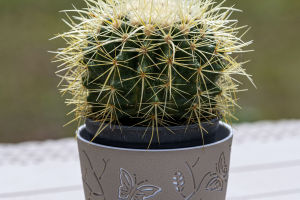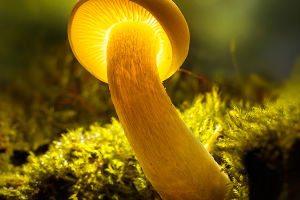Recently, a funny story went viral: a pot of students' clothes left for a long time grew mushrooms. However, mushrooms not only can crawl onto clothes but can also fly and burrow underground.
The omnipresent mushroom spores
Although they may not be visible to the eye, mushrooms are all around us. Mushrooms emit millions of tons of spores into the atmosphere every year. These spores float in the air, land on distant soil, or attach to our clothes, and then are brought into closets by us, where they grow on clothes or in corners of the wardrobe. Spores can even run into the sky with the wind, and scientists have found mushroom spores in clouds.
Today, scientists believe that mushroom spores can promote cloud formation. This is because the condensation of water vapor in the atmosphere into water droplets requires condensation nuclei, which can be chemical solution droplets such as chloride, nitrogen, and carbon, or solid particles such as tiny dust. The more condensation nuclei, the more conducive to the condensation of water vapor into water droplets, thereby forming clouds.
As a tiny solid substance, mushroom spores can provide a large number of condensation nuclei for water droplets, thereby promoting cloud formation. If it rains, the spores will fall to the ground with the raindrops, then take root and complete the spread.
In addition to spreading by spores, mushrooms also rely on mycelium growing on the surface or underground to expand their territory. Mycelium is a very effective way of spreading mushrooms. It is similar to the roots of plants, but smaller and longer. Mycelium can not only root in the soil but also in modern urban garbage dumps.
If you dig up soil containing mycelium, you will find that the mycelium keeps extending, with a total distance of up to 100 meters. The longest mycelium in the world is in the United States, which is 10 kilometers long, weighs hundreds of tons, and is also the longest-lived mycelium, with an age of 2400 years.
The relationship between mushrooms and fungi
The relationship between mushrooms and fungi is like that between fruit or flowers and plants.
Mushrooms are just where fungi produce spores, and not all fungi will grow mushrooms. The vast majority of fungi can produce spores without mushrooms. Compared with the millions of tons of mushrooms, fungi produce about 45 million tons of spores every year.
Fungi appeared on Earth as early as one billion years ago, and from more than 400 million years ago to now, they have maintained important symbiotic relationships with most plants. Fungi combine with plant roots to form mycorrhiza. Fungi are responsible for promoting the absorption of inorganic substances such as nitrates and phosphates by plants, and plants provide fungi with some organic substances synthesized by photosynthesis.
More than 90% of plants have mycorrhizae, and many plants cannot survive without fungi. In addition to forming mycorrhizae, fungi also combine with algae and other organisms to form a close network. In some environments, these networks can even replace tree roots, tightly binding the soil together, thereby maintaining water and soil, and lichens are representatives of them.
Lichens in the sky and underground
Lichens are symbiotic organisms formed by the combination of fungi and photosynthetic algae or bacteria.
This symbiotic organism can survive in some incredible environments. Even in the Sahara Desert, lichens can be found. They not only thrive on some hot sand but also stabilize the sand surface, reducing the formation of sandstorms.
Scientists have also found lichens in Antarctica. They live in a secluded paradise far from humans. Although they live in an extremely cold environment with high-intensity ultraviolet radiation, none of this seems to be a problem. This is not surprising, as lichens have also been taken into space.
Love for symbiosis and mutual assistance
In addition to symbiosis with plants, algae, and bacteria, fungi can also symbiotically associate with animals, such as ants.
Different species of leaf-cutting ants form mutualistic symbioses with different fungi. Leaf-cutting ants cultivate symbiotic fungi with chopped leaves and remove other organisms that threaten fungi, while fungi produce expanded mycelium to supply food to leaf-cutting ants.
Infinite future potential
In 2017, researchers reconstructed the diet of Neanderthals from more than 40,000 years ago and found that a kind of mold appeared in the diet of a Neanderthal with dental disease.
Therefore, researchers speculate that fungi had already entered human life at that time. By 1928, the formal discovery of the antibiotic penicillin saved countless lives, and penicillin came from Penicillium.
Fungi are now the source of many important drugs. Cyclosporin, extracted from the fungus Tolypocladium inflatum, is currently the safest and most effective immunosuppressant.
For example, cyclosporin reduces the rejection reaction caused by organ transplantation by inhibiting immune reactions, thereby increasing the success rate of organ transplantation (but due to the suppression of immune reactions, cyclosporin also brings side effects of susceptibility to infection). For example, psilocybin, extracted from psychedelic mushrooms, can effectively relieve severe depression and anxiety.
The role of fungi for humans is far more than this. Scientists estimate that there are between 2.2 million and 3.8 million species of fungi in the world, and humans currently only recognize 6% of them. Human understanding of fungi has just begun, who knows what surprises fungi will bring to humans in the future?


